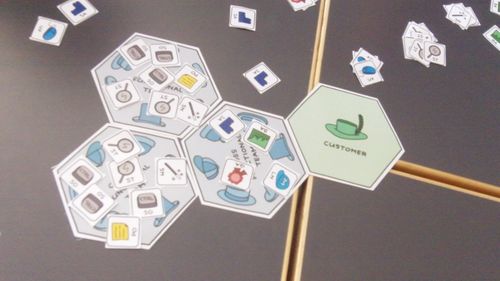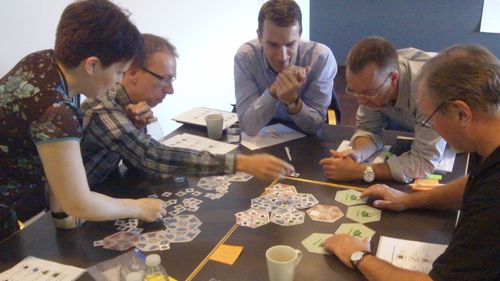The value stream is a potentially harmful metaphor. I think we should replace value streams…
Meddlers (Free Exercise)
A very popular exercise is the Meddlers game (named after a very popular German board game). The exercise allows players to visualize and discuss organizational structures.
In order to play this game you have to download this PDF, then print and cut the tiles and pieces on sturdy paper.
Create Challenges
The exercise is actually very simple. Players give each other challenges by explaining a situation, a goal, and a number of constraints. For example:
- You have a business unit of 18 people, responsible for 2 big customers and 2 small ones. What could the organizational structure look like?
- You have a startup company of 15 people, offering Software as a Service to a hundred different customers. How will you grow it?
- You are a development manager in an enterprise, responsible for distributed teams in three countries. How will people collaborate?
The result of the exercise should be an organizational structure, consisting of one or more teams, where each team contains one or more roles.
Game Rules
There are actually very few game rules. Only two things are worth pointing out:
- A functional team should contain only people with the same role. A cross-functional team has people with different roles.
- By connecting the sides of teams you visualize that the teams are collaborating and providing value to each other.
Players can deviate from the rules, and bend the constraints, in any way they like. Some people add extra roles to their structures. Some people connect tiles in creative ways. Some people position roles across boundaries or outside of the teams. Some people combine roles into one. Everything is allowed, as long as the players can explain what the benefits and the risks are.
Value Networks
The objective of the game is to facilitate discussions about organizational structures, where multiple teams work on multiple projects. Using this game for such discussions has several positive effects:
- People are forced to work in a flat surface. This means they cannot grow the organization as a hierarchy. They must grow their business as a value network.
- The constraints of the game clearly suggests to put people in teams (instead of having them work solo) and to limit the size of the teams to fewer than 10 team members.
- This game makes it easier for managers to let employees invent their own team structures, and to have them discuss benefits and risks and the value the teams are providing to each other.
The exercise has no clearly defined outcome in terms of winners and losers. When players better understand how to grow their organization as a value network, then everyone is a winner!





